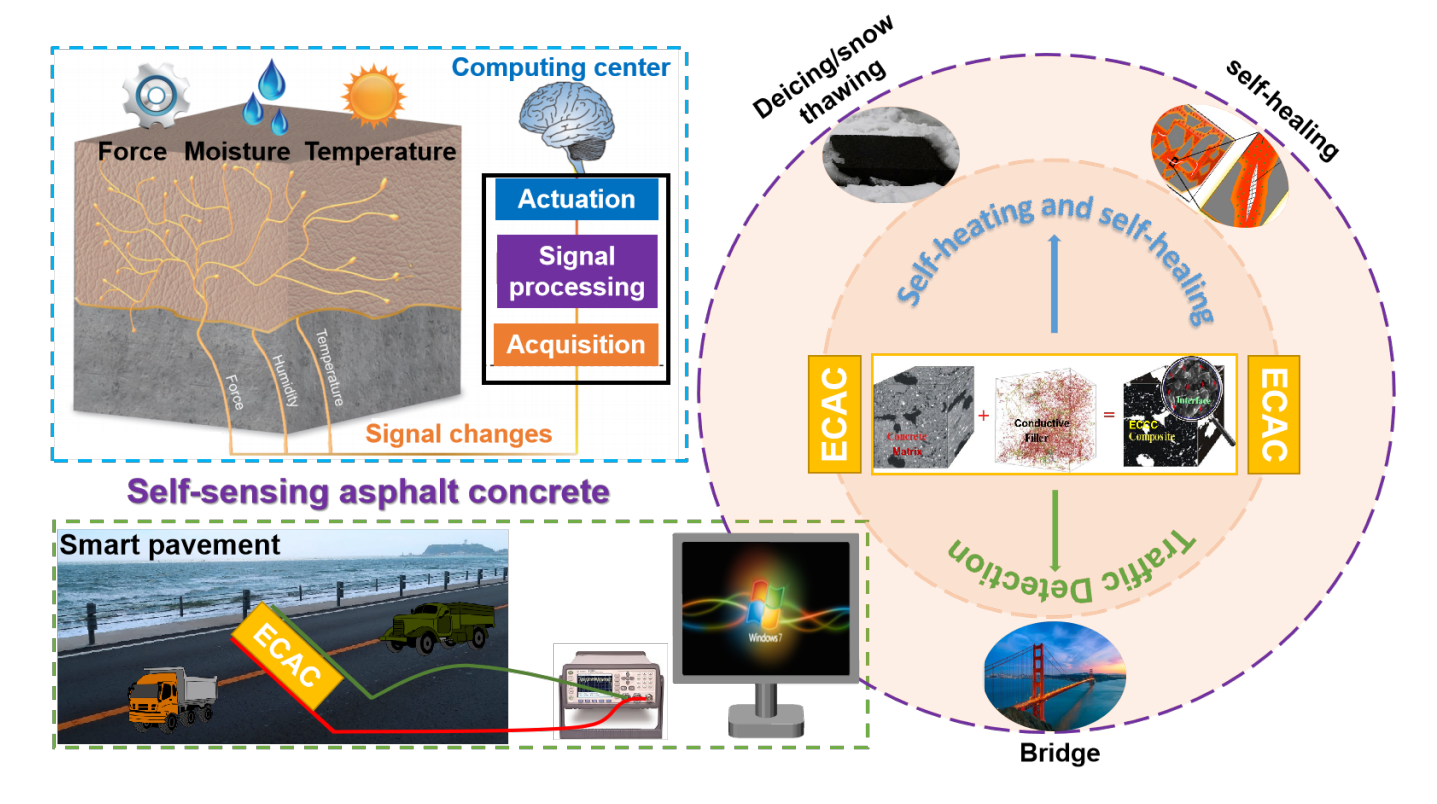1. Sustainable Pavement Materials and Technologies
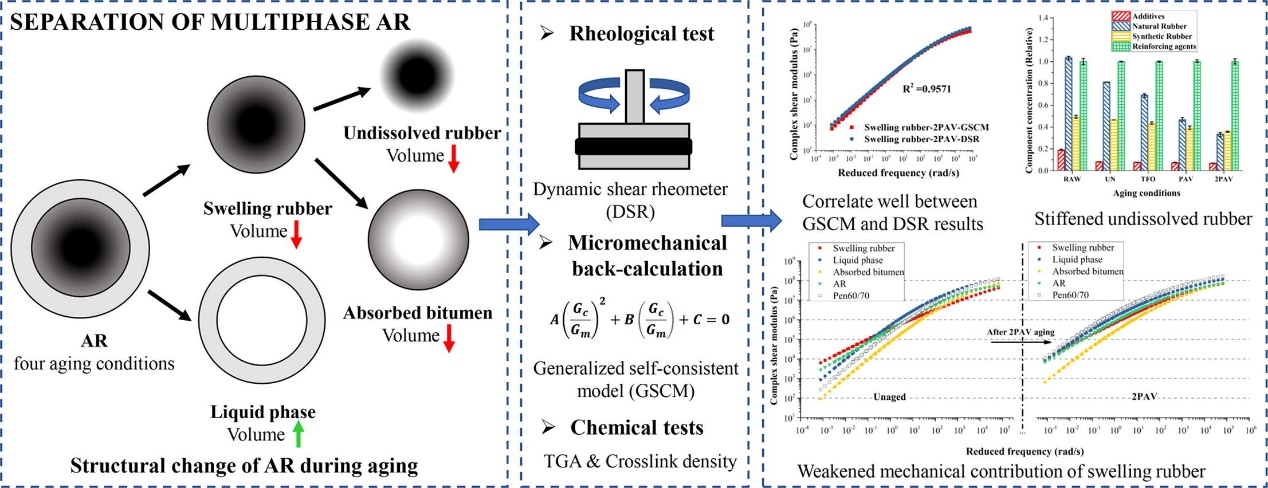
Recycled from waste tires, crumb rubber modifier (CRM) is added into bitumen to produce the rubberized asphalt with superior performances and several environmental benefits. Rubberized asphalt pavement can be categorized in to dry process and wet process, which can be further divided into the Asphalt Rubber (AR) and Terminal Blend (TB). Our research group has paved one trial sections of warm asphalt rubber pavement in Fo Tan Road, Hong Kong, which has shown outstanding performance and noise-reduction effect. Our research group now is focusing on the aging and recycling mechanisms of asphalt rubber pavement and the development of more advanced rubberized asphalt technologies.

Reactive resins, such as epoxy resin and polyurethane, are widely used in composites, coatings, and high-end functional materials. In pavement engineering, epoxy resin has been used to manufacturing high-performance paving material for airfield runways and steel bridge decks. Polyurethane recently has emerged as a strong modifier or bonding material in pavement construction. Both epoxy resin and polyurethane can improve the high-temperature performance, resistance to moisture damage, and fatigue properties of asphalt pavement. Our research team is devoted to the development of a new generation of high-performance paving material for steel bridge paving, pavement anti-skid sealing, etc., which will significantly improve the durability and resilience of the transportation
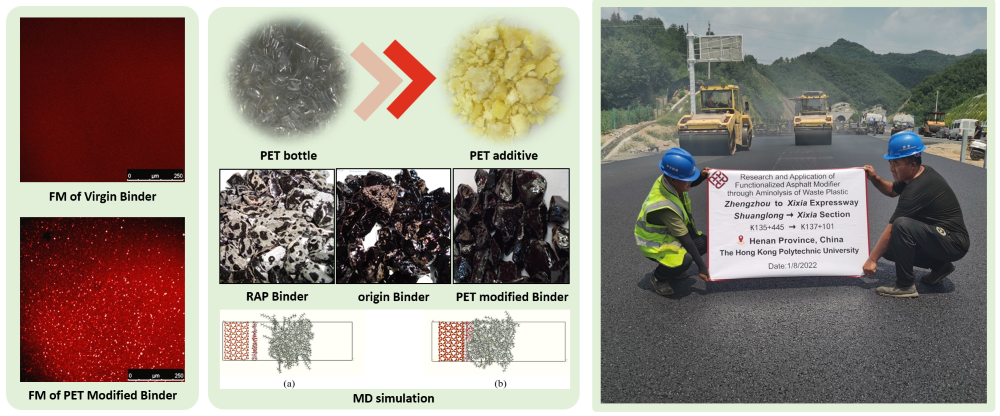
Waste plastic pollution is one of the most pressing environmental problems worldwide, and this problem is especially prominent in high-density cities like Hong Kong. Among various waste plastic recycling methods, reusing them or their derived products in roadway construction has recently emerged as an attractive option. Our recent research mainly focuses on the advanced recycling of waste plastic (e.g. PET bottle, PP mask, PE film) and value-added additive development for asphalt pavement and their environmental assessment. We also explore the impact of environmental factors, such as moisture, high temperature, UV, and oxidation on the modified asphalt, to find a better way to improve the anti-strip, high-temperature, and long-term fatigue life of asphalt pavement.
2. Non-Destructive Evaluation of Infrastructure
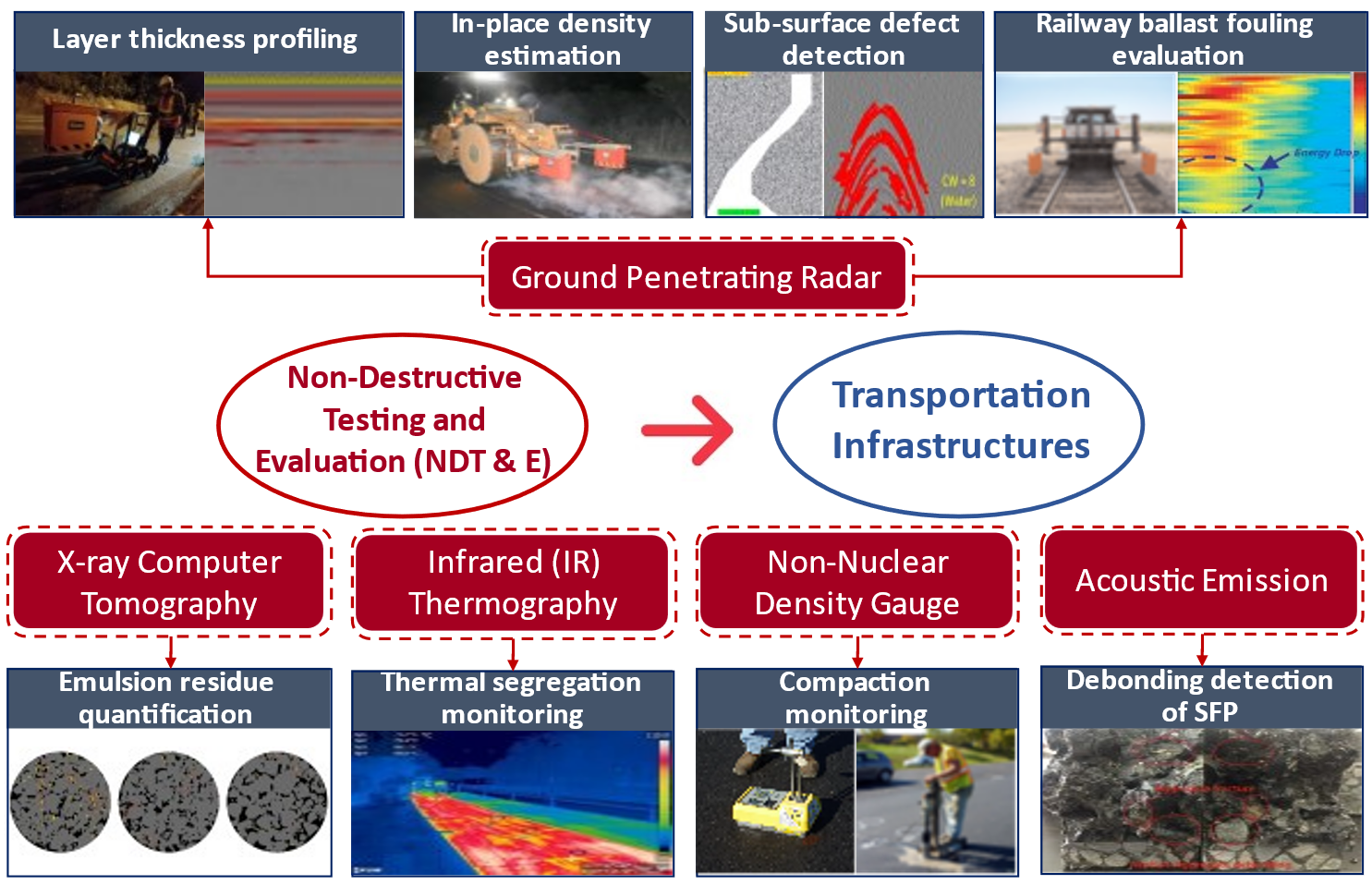
Non-destructive testing and evaluation (NDT&E) methods are utilized by our group to assess the condition of various structural components of in-service highway infrastructure assets, such as pavement, bridges, and tunnels, without damaging them. Routine inspection of transportation infrastructure using NDT&E techniques is vital to ensure its structural and functional serviceability. Our research group fulfils the need for unbiased expertise to evaluate emerging NDT&E technologies, as well as data analysis, fusion, and interpretation. The ground-penetrating radar (GPR) technique has been successfully implemented by group researchers for asphalt pavement layer thickness profiling, in-place density estimation, sub-surface defects detection, and railway ballast fouling evaluation. We also developed real-time processing techniques incorporating advanced artificial intelligence algorithms for high-quality data interpretation. Besides GPR, the non-nuclear density gauge (NNDG) and Infrared (IR) thermography methods are utilized to provide real-time compaction degree and thermal segregation monitoring during asphalt pavement construction. We also apply acoustic emission (AE), X-ray CT, and digital cameras in multi-scale distress detection of asphalt pavement.
3. Multiscale Characterization and Modeling of Asphalt Pavement
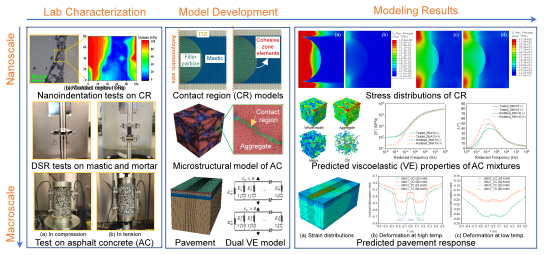
Asphalt concrete (AC) is a particulate-filled material composed of asphalt binder, aggregates, and air voids, widely used in pavement construction. Due to its high heterogeneity, AC exhibits complex mechanical behavior and further complicates pavement performance under traffic loads and climatic conditions. To understand the underlying mechanisms of AC’s and asphalt pavement’s performance, our recent research mainly focuses on the multiscale characterization and modeling of asphalt pavement, especially the effect of AC’s tension-compression (TC) asymmetry on asphalt pavement response. At the microscale, the contact region (CR), referring to the narrow area between aggregates in contact, was characterized, and its mechanical behavior was predicted by the developed micromechanical model. At the mesoscale, the CT-based AC model was developed to predict AC’s dynamic response. At the macroscale, a dual viscoelastic constitutive model was developed to introduce AC’s TC asymmetry into pavement modeling. The outcomes from the modeling results are expected to help enhance the design and maintenance of durable asphalt pavements.
4. Pavement Management and Sustainability Assessment
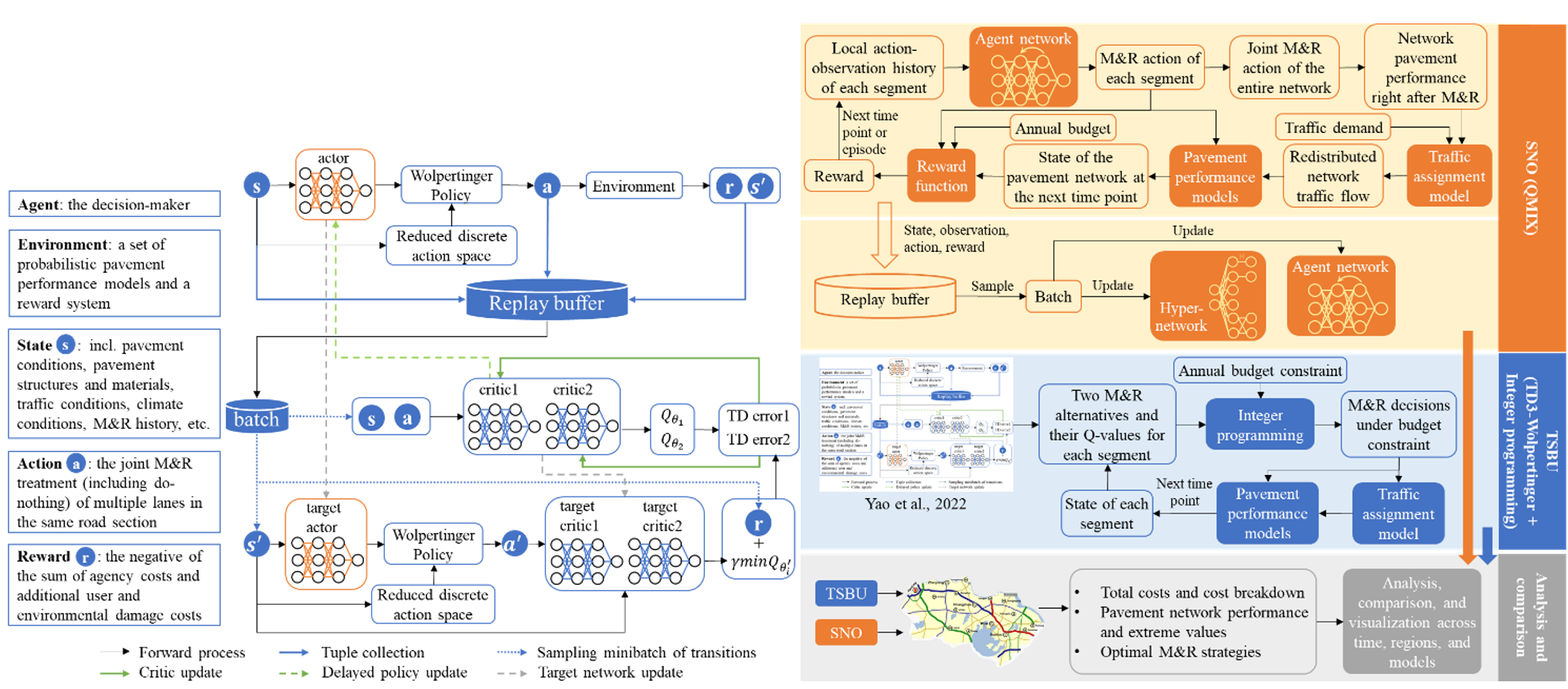
Pavement systems are essential elements of transportation infrastructure. However, the ever-increasing road travel demand has significantly accelerated the aging of road infrastructure. The deteriorated pavements incur high maintenance cost, increased vehicle operating cost, and extra fuel consumption and greenhouse gas (GHG) emissions, which significantly affect the sustainability of road pavements. The limited financial and natural resources available to manage the expanding road network have posed significant challenges to transport agencies in effectively managing their pavement networks. Our current research mainly focuses on developing an intelligent and sustainable pavement management framework for highway asphalt pavement networks, that are featured with providing lane-specific maintenance strategies for large-scale pavement networks, considering uncertainty to achieve managerial flexibility, incorporating decision makers' attitudes toward risk and opportunity into maintenance optimization, and integrating the functional dependence of road segments into long-term pavement maintenance planning.
5. Environmental Impact of Asphalt Pavement
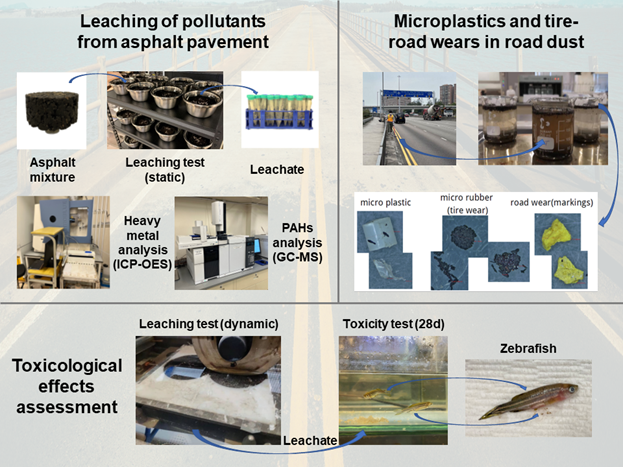
Asphalt pavement, a major type of road surface, may contain hazardous components (e.g., heavy metals, organic chemicals) depending on the sources of mineral aggregates and bitumen. The leaching of pollutants from asphalt pavement is a complex process. The application of asphalt modifications and the reuse of waste materials in asphalt pavement make this process more complicated. Our recent research mainly focuses on the leaching behaviors of heavy metals and polycyclic aromatic hydrocarbons (PAHs) from various types of asphalt paving materials, the leaching kinetics of specific metals (e.g., Cu, Pb, Zn) and their relationships with the asphalt mix design, the toxicological effects of the leachates to the aquatic animals, as well as the risk assessment on the leachates of asphalt pavement. In addition, we are also investigating the environmental impact of asphalt pavement under daily traffic, focusing on the analysis of micro-rubber generated from tire-road wear.
6. Smart/Functional Pavement Materials and Technologies
Road
pavements are designed to withstand road traffic and weathering actions while
ensuring comfortable and safe riding conditions as well as low costs and damage
to the environment. When a road pavement has additional abilities or reacts to
an external stimulus, it is considered to be smart and multifunctional.
Examples of such abilities that have been investigated in asphalt mixtures are
self-sensing, deicing/anti-icing, and self-healing abilities. Typically, these
abilities are achieved by directly adding functional fillers, such as metal
fiber, carbon fiber, carbon black, carbon nanotubes, and graphene, into asphalt
binder and then binding it with aggregates and filler. The application of conductive asphalt mixtures
can improve the safety and lifespan of the pavement, as well as reduce
maintenance costs during the service. In this context, they can contribute to
materializing the transition to a novel model known as “Smart, Multifunctional,
and Sustainable pavement” that is environmentally friendly, sustainable, and
inclusive. This model is a very important path toward economic and employment
recovery, a vision to which many countries are strongly committed.
